In this article
View 3 More +You undoubtedly have heard the terms “purebred” and “mixed breed.” The former describes a dog resulting from the mating of two dogs of the same breed. The latter can have parents of any canines that aren’t the same breed. The result can be a one-off without any aim to reproduce the same pairing. They can also include more than two breeds if both the parents are mongrels. Then, there are some pooches called designer dogs. But what exactly is a designer dog?
Designer dogs are the offspring of two parent breeds with desirable traits with the purpose of creating a better dog overall. It could involve a different size or specific characteristics, like non-shedding or temperament. Let’s learn a bit more about this type of breeding.

The History of Designer Dogs
Wally Conron spurred the creation of designer dogs with his development of the Labradoodle, which is a cross between the Labrador Retriever and Standard Poodle. Both dogs are lovable and excellent pets. The latter brings a dog that doesn’t shed, but contrary to popular belief, this pooch isn’t hypoallergenic. Such an animal doesn’t exist. If you see the term “hypoallergenic,” it’s simply marketing with no factual or scientific basis. It usually just means the dog sheds less than other breeds, although that doesn’t mean you won’t experience any allergy symptoms.
Conron put the Labradoodle into the spotlight in the late 1980s. The rest, as they say, is history. The dog was an incredible hit! We mentioned the agreeable temperaments of the parent breeds. The puppies are also so darn cute. They practically sold themselves. Sadly, demand fueled the supply in an unfortunate way with the rise of puppy mills overbreeding dogs to capitalize on the hybrid.
Other combinations came to the forefront, with the three sizes of the Poodle a favorite breed. Today, you’ll see various dogs, such as Cockapoo, Yorkie Poo, Cavapoo, and Saint Berdoodle. This influx hasn’t set well with many organizations, like The Poodle Club of America. They vehemently oppose such crossbreeding because of the risks to the breed’s integrity and the potential issues with hybrid puppies.

The Problems With Designer Dogs
Let’s put the concerns of The Poodle Club of America in context. Breeders of purebred dogs go to great lengths to ensure the health of the offspring. Many clubs require individuals to conduct pre-breeding screenings to avoid passing on deleterious hereditary and congenital conditions to the puppies. Many can affect the animals’ quality of life and even survival. The emotional toll is unfathomable.
Reputable breeders get the testing recommended by their parent clubs and the Orthopedic Foundation for Animals (OFA). Prospective buyers can get this information through the sellers and the organization. It’s a safeguard for everyone to make the test results transparent. It’s worth noting that many parent clubs require breeders to do these screenings.
Unfortunately, you don’t get this same assurance with a designer dog. Sellers may get their puppies vaccinated and do the necessary deworming; however, many conditions appear later in life. Pre-breeding health screenings could spare everyone the agony of owning a dog with a potentially life-threatening condition, to say nothing of the expense.
Puppy Mills
One of the saddest and most serious consequences of designer dogs has been the rise of puppy mills. The term is unfortunate but accurate in its description of money-hungry backyard breeders keeping dogs in deplorable conditions to make a buck selling them. Many of these places view optimal care as an unnecessary expense.
The accounts are heartbreaking of dogs without outdoor access, the lack of adequate veterinary care, and the poor health of the breeding stock. One of the problems is a lack of enforcement for providing humane conditions for the animals. Many states don’t have laws and regulations to protect dogs, making it even more difficult to contain the problem. However, it doesn’t stop there.

Dangerous Crossings
One of the most dangerous outcomes of designer dogs is the breeding of so-called teacup variants of various breeds. Teacup Chihuahuas and Poodles are not recognized by their parent clubs. The pups are the product of breeding runts for profit at the expense of the animals. Remember that they are dogs that have struggled through puppyhood, often with lingering health issues. It also exists with mini versions.
Another insidious fallout of designer dogs is the rise of dangerous crossings. They typically involve breeds of widely disparate sizes, such as the Aussie-Chi, a cross between the Australian Shepherd and Chihuahua. The former can get up to 65 pounds, whereas the latter is typically under 6 pounds. Potential problems also exist with breeding dogs with both possessing the merle trait.
Parent clubs provide the necessary oversight to avoid this crossbreeding. The American Kennel Club (AKC) also won’t allow new breeds created by selectively breeding two registrable breeds. Remember that puppies don’t necessarily have a 50-50 split of genes from their parents. It’s genetic roulette for every gene, with most outcomes not dependent upon another.
An AKC-registered breed has a pedigree going back at least 40 years and a sizable population to prevent inbreeding. That allows for consistency between the generations and the development of an official standard. Most designer dogs lack this stability. You can’t be sure of what you’re getting with so few generations.
The Consequences of Unscrupulous Backyard Breeders and Puppy Mills
Reputable breeders go the extra mile because their livelihood and reputation depend on them selling healthy puppies. You’ll likely find that these individuals will screen you to ensure you’ll be a good pet owner. They will offer a health guarantee for their pups and give you a complete medical history. You can see the mother and littermates. You may also have to wait until the puppy is over 12 weeks old.
That may seem long, but it’s in the dog’s best interest. Puppies separated from their groups at less than 8 weeks old are more likely to be fearful and have other behavioral issues. That increases their risk of relinquishment and a poor quality of life. The problem with designer dogs is a lack of control to ensure these things don’t happen.

Tips for Buying a Designer Dog
We don’t deny that some crossings are desirable nor are all breeders in it for the money. However, you must research the sellers before you buy. We’ve already mentioned things, such as a health guarantee and a complete medical history. We strongly urge you to purchase only sellers who conduct pre-breeding health screenings. They should freely offer this information upon request.
If they don’t, walk away before you fall in love with a puppy. Get these answers before you view the pups. Failure to do so sets you and your family up for heartbreak. A reputable seller understands and respects these concerns. We also suggest searching for information about the designer dog. Many have existed for a while, offering some details about what to expect. Others have no history at all.

Final Thoughts
Designer dogs are a modern-day riff on how people developed different pups through selective breeding. The problem is that profit is part of the equation. Wally Conron regretted his part in this craze because of its possible connection to puppy mills. We recommend proceeding with caution. Research the designer dog, the claims, and the seller to make an informed choice.
Featured Image Credit: Lopolo, Shutterstock


















